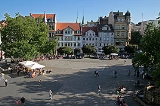
Braunschweig
Encyclopedia
Braunschweig (ˈbʁaʊnʃvaɪk; Low German
: Brunswiek ˈbrɔˑnsviːk; Brunswick), is a city of 247,400 people, located in the federal-state of Lower Saxony
, Germany. It is located north of the Harz
mountains at the farthest navigable point of the Oker
river, which connects to the North Sea
via the rivers Aller
and Weser.

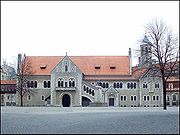 The date and circumstances of the town's foundation are unknown. Tradition maintains that Braunschweig was created through the merger of two settlements, one founded by Bruno II
The date and circumstances of the town's foundation are unknown. Tradition maintains that Braunschweig was created through the merger of two settlements, one founded by Bruno II
, a Saxon count who died before 1017 on one side of the river Oker – the legend gives the year 861 for the foundation – and the other the settlement of a legendary Count Dankward, after whom Dankwarderode Castle
(Dankward's clearing), which was reconstructed in the 19th century, is named. The town's original name of Brunswik is a combination of the name Bruno and Low German wik, a place where merchants rested and stored their goods. The town's name therefore indicates an ideal resting-place, as it lay by a ford across the Oker River. Another explanation of the city's name is that it comes from Brand, or burning, indicating a place which developed after the landscape was cleared through burning. The city was first mentioned in documents from the St. Magni Church from 1031, which give the city's name as Brunesguik.
In the 12th century Duke Henry the Lion
made Braunschweig the capital of his state and built the Cathedral of St. Blasius. He became so powerful that he dared to refuse military aid to the emperor Frederick I Barbarossa, which led to his condemnation and fall.
Braunschweig was a member of the Hanseatic League
from the 13th century to the middle of the 17th century. In the 18th century Braunschweig was not only a political, but also a cultural centre. Emilia Galotti
by Lessing and Goethe
's Faust
were performed for the first time in Braunschweig.
Braunschweig was at times one of the residences of the rulers of the Duchy of Brunswick-Lüneburg, which was a constituent state of the Holy Roman Empire
until 1806 and of the German Empire
from 1871. At the end of World War I
the Duchy became the Free State of Brunswick
within the Weimar Republic
.
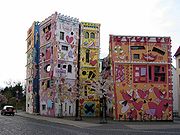
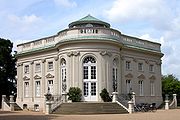
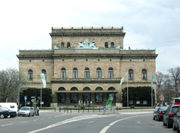
 During World War II
During World War II
thousands of forced Eastern workers were brought to the city. During the years 1943–1945 at least 360 children taken away from the workers died in the Entbindungsheim für Ostarbeiterinnen
.
In World War II
, Braunschweig was a Sub-area Headquarters (Untergebiet Hauptquartier) of Military District (Wehrkreis) XI. It was also the garrison city of the 31st Infanterie Division, which took part in the invasions of Poland, Belgium, France, and Russia, and was largely destroyed during the German withdrawal from Russia. The city was severely damaged by Anglo-American aerial attacks. The air raid on October 15, 1944
destroyed most of the Altstadt (old town), which had been the largest ensemble of half-timbered houses in Germany, as well as most of the churches. The Cathedral, which had been converted to a National shrine (German: Nationale Weihestätte) by the Nazi
-Government, still stood.
After the war, Braunschweig ceased to be a capital when the Free State of Brunswick was dissolved by the Allied occupying authorities
(most of its lands were incorporated in the newly formed state of Lower Saxony
). The Cathedral was restored to its function as a Protestant church. The rebuilding of the city was intended to make it modern and automobile-oriented. A small section of the Altstadt survived the bombing and remains quite distinctive. In the 1990s efforts increased to reconstruct historic buildings that had been destroyed in the air raid. Buildings such as the "Alte Waage" (originally built in 1534) now stand again in their pre-war glory.
(Salzgitter—Wolfsburg). City roads are generally wide, built after World War II
to support the anticipated use of the automobile. There are several car parks in the city.
and Berlin. Deutsche Bahn
(German Railways) serves the city with local, inter-city and high-speed InterCityExpress
(ICE) trains, with frequent stops at the Hauptbahnhof
(main train station).
Tram lines:
M1: Wenden – Stöckheim
M2: Siegfriedviertel – Heidberg
M3: Volkmarode – Weststadt Weserstraße
M4: Radeklint – Helmstedter Straße
M5: Hauptbahnhof – Broitzem
, Indonesia
(since 1960) Nîmes
, France (since 1962) Bath, England, United Kingdom (since 1971) Sousse
, Tunisia
(since 1980) Qiryat Tivon
, Israel
(since 1985/1986) Magdeburg
, Germany (since 1987) Kazan
, Russian Federation
(since 1988) Omaha
, Nebraska
, United States (since 1992)
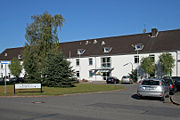 Many other geographical locations are named after Braunschweig such as New Brunswick
Many other geographical locations are named after Braunschweig such as New Brunswick
in Canada due to the personal union
of the Duchy of Hanover with Great Britain from 1714 to 1837 (see House of Hanover
, also referred to as the House of Brunswick, Hanover line). For a list of places named after Braunschweig see Brunswick (disambiguation).
Today it is known for its University and research institutes, mainly the Johann Heinrich von Thuenen Institute, until the end of 2007 named Federal Agricultural Research Centre, and the Physikalisch-Technische Bundesanstalt
(PTB). The PTB Braunschweig maintains the atomic clock
responsible for the DCF77
time signal and the official German time. The region of Braunschweig is the most R&D-intensive area in the whole European Economic Area
investing 7.1% of its GDP for research & technology. Braunschweig was named Germany's City of Science 2007 .
, Hoffmann von Fallersleben, Richard Dedekind
and Louis Spohr
. Since 2005, Braunschweig has an international school.
Lower Saxony
's only university of art, founded in 1963, can be found in Braunschweig. Its German name is "Hochschule für Bildende Künste Braunschweig".
companies, both known worldwide for the high quality of their instruments: Schimmel
and Grotrian-Steinweg (cf. Steinway
). Both companies were founded in the 19th century.
, a medieval jester who played many practical jokes on its citizens.
It also had — and still has — many breweries, and still a very peculiar kind of beer
is made called Mumme (see :de:Braunschweiger Mumme), first quoted in 1390, a malt-extract that was shipped all over the world.
Near Braunschweig at Cremlingen-Abbenrode, there is a large medium wave transmitter, which transmits the program of "Deutschlandfunk" on 756 kHz, the Cremlingen transmitter
.
The Braunschweig Airport
(BWE / EDVE) is located north of the city at 52°19′N 10°33′E, elev. 295 ft (89.9 m)
Braunschweiger
liverwurst
is named after the city.
is an annual classical music festival. It is the largest promoter of classical music in the region and one of the most prominent music festivals in Lower Saxony
.
Sandberg Guitars headquarters is in Braunschweig.
. Founded in 1895, the club can look back on a long and chequered history. It won the German football championship in 1967. Despite playing the German 2nd Soccer division now (2011-2012 season), the club still attracts a large number of supporters.
The Braunschweig Lions
is the city's American football
team, seven times German Bowl Defender and two times Eurobowl champion.
Low German
Low German or Low Saxon is an Ingvaeonic West Germanic language spoken mainly in northern Germany and the eastern part of the Netherlands...
: Brunswiek ˈbrɔˑnsviːk; Brunswick), is a city of 247,400 people, located in the federal-state of Lower Saxony
Lower Saxony
Lower Saxony is a German state situated in north-western Germany and is second in area and fourth in population among the sixteen states of Germany...
, Germany. It is located north of the Harz
Harz
The Harz is the highest mountain range in northern Germany and its rugged terrain extends across parts of Lower Saxony, Saxony-Anhalt and Thuringia. The name Harz derives from the Middle High German word Hardt or Hart , latinized as Hercynia. The legendary Brocken is the highest summit in the Harz...
mountains at the farthest navigable point of the Oker
Oker
The Oker is a river in Lower Saxony, Germany, that has historically formed an important political boundary. It is a left tributary of the River Aller, in length and runs in a generally northerly direction.- Course :...
river, which connects to the North Sea
North Sea
In the southwest, beyond the Straits of Dover, the North Sea becomes the English Channel connecting to the Atlantic Ocean. In the east, it connects to the Baltic Sea via the Skagerrak and Kattegat, narrow straits that separate Denmark from Norway and Sweden respectively...
via the rivers Aller
Aller
The Aller is a river, long, in the states of Saxony-Anhalt and Lower Saxony in Germany. It is a right-hand, and hence eastern, tributary of the River Weser and is also its largest tributary. Its last form the Lower Aller federal waterway...
and Weser.
History


Brun I, Count of Brunswick
Brun , was count in the Derlingau, the Nordthüringgau, the Hastfalagau, the Salzgau, the Gau Gretinge, and the Gau Mulbeze, with Brunswick as his residence. Brun was a member of the Brunones dynasty....
, a Saxon count who died before 1017 on one side of the river Oker – the legend gives the year 861 for the foundation – and the other the settlement of a legendary Count Dankward, after whom Dankwarderode Castle
Dankwarderode Castle
Dankwarderode Castle on the Burgplatz in Brunswick is a Saxon lowland castle. It was the residence of the Brunswick dukes for centuries and, today, is part of the Herzog Anton Ulrich Museum....
(Dankward's clearing), which was reconstructed in the 19th century, is named. The town's original name of Brunswik is a combination of the name Bruno and Low German wik, a place where merchants rested and stored their goods. The town's name therefore indicates an ideal resting-place, as it lay by a ford across the Oker River. Another explanation of the city's name is that it comes from Brand, or burning, indicating a place which developed after the landscape was cleared through burning. The city was first mentioned in documents from the St. Magni Church from 1031, which give the city's name as Brunesguik.
In the 12th century Duke Henry the Lion
Henry the Lion
Henry the Lion was a member of the Welf dynasty and Duke of Saxony, as Henry III, from 1142, and Duke of Bavaria, as Henry XII, from 1156, which duchies he held until 1180....
made Braunschweig the capital of his state and built the Cathedral of St. Blasius. He became so powerful that he dared to refuse military aid to the emperor Frederick I Barbarossa, which led to his condemnation and fall.
Braunschweig was a member of the Hanseatic League
Hanseatic League
The Hanseatic League was an economic alliance of trading cities and their merchant guilds that dominated trade along the coast of Northern Europe...
from the 13th century to the middle of the 17th century. In the 18th century Braunschweig was not only a political, but also a cultural centre. Emilia Galotti
Emilia Galotti
Emilia Galotti is a play in five acts by Gotthold Ephraim Lessing , which premiered on 8 March 1772 in Brunswick . The work is a classic example of German bürgerliches Trauerspiel . Other works in this category include Schiller's Kabale und Liebe and Hebbel's Maria Magdalene...
by Lessing and Goethe
Johann Wolfgang von Goethe
Johann Wolfgang von Goethe was a German writer, pictorial artist, biologist, theoretical physicist, and polymath. He is considered the supreme genius of modern German literature. His works span the fields of poetry, drama, prose, philosophy, and science. His Faust has been called the greatest long...
's Faust
Goethe's Faust
Johann Wolfgang von Goethe's Faust is a tragic play in two parts: and . Although written as a closet drama, it is the play with the largest audience numbers on German-language stages...
were performed for the first time in Braunschweig.
Braunschweig was at times one of the residences of the rulers of the Duchy of Brunswick-Lüneburg, which was a constituent state of the Holy Roman Empire
Holy Roman Empire
The Holy Roman Empire was a realm that existed from 962 to 1806 in Central Europe.It was ruled by the Holy Roman Emperor. Its character changed during the Middle Ages and the Early Modern period, when the power of the emperor gradually weakened in favour of the princes...
until 1806 and of the German Empire
German Empire
The German Empire refers to Germany during the "Second Reich" period from the unification of Germany and proclamation of Wilhelm I as German Emperor on 18 January 1871, to 1918, when it became a federal republic after defeat in World War I and the abdication of the Emperor, Wilhelm II.The German...
from 1871. At the end of World War I
World War I
World War I , which was predominantly called the World War or the Great War from its occurrence until 1939, and the First World War or World War I thereafter, was a major war centred in Europe that began on 28 July 1914 and lasted until 11 November 1918...
the Duchy became the Free State of Brunswick
Free State of Brunswick
The Free State of Brunswick was the republic formed after the abolition of the Duchy of Brunswick in the course of the German Revolution of 1918–19. It was a state of the German Reich in the time of the Weimar Republic and Nazi Germany.-History:...
within the Weimar Republic
Weimar Republic
The Weimar Republic is the name given by historians to the parliamentary republic established in 1919 in Germany to replace the imperial form of government...
.




World War II
World War II, or the Second World War , was a global conflict lasting from 1939 to 1945, involving most of the world's nations—including all of the great powers—eventually forming two opposing military alliances: the Allies and the Axis...
thousands of forced Eastern workers were brought to the city. During the years 1943–1945 at least 360 children taken away from the workers died in the Entbindungsheim für Ostarbeiterinnen
Ausländerkinder-Pflegestätte
Ausländerkinder-Pflegestätte , also Säuglingsheim, Entbindungsheim, were Third Reich institutions where babies and children, abducted from Eastern European forced laborers from 1943 to 1945, were kept.-Nazi policy:...
.
In World War II
World War II
World War II, or the Second World War , was a global conflict lasting from 1939 to 1945, involving most of the world's nations—including all of the great powers—eventually forming two opposing military alliances: the Allies and the Axis...
, Braunschweig was a Sub-area Headquarters (Untergebiet Hauptquartier) of Military District (Wehrkreis) XI. It was also the garrison city of the 31st Infanterie Division, which took part in the invasions of Poland, Belgium, France, and Russia, and was largely destroyed during the German withdrawal from Russia. The city was severely damaged by Anglo-American aerial attacks. The air raid on October 15, 1944
Bombing of Braunschweig in World War II
During World War II Braunschweig was attacked by Allied aircraft in 42 bombing raids.The attack on the night of 14/15 October 1944 by No. 5 Group Royal Air Force marked the high point of the destruction of Henry the Lion's city in the Second World War...
destroyed most of the Altstadt (old town), which had been the largest ensemble of half-timbered houses in Germany, as well as most of the churches. The Cathedral, which had been converted to a National shrine (German: Nationale Weihestätte) by the Nazi
Nazism
Nazism, the common short form name of National Socialism was the ideology and practice of the Nazi Party and of Nazi Germany...
-Government, still stood.
After the war, Braunschweig ceased to be a capital when the Free State of Brunswick was dissolved by the Allied occupying authorities
Allied Occupation Zones in Germany
The Allied powers who defeated Nazi Germany in World War II divided the country west of the Oder-Neisse line into four occupation zones for administrative purposes during 1945–49. In the closing weeks of fighting in Europe, US forces had pushed beyond the previously agreed boundaries for the...
(most of its lands were incorporated in the newly formed state of Lower Saxony
Lower Saxony
Lower Saxony is a German state situated in north-western Germany and is second in area and fourth in population among the sixteen states of Germany...
). The Cathedral was restored to its function as a Protestant church. The rebuilding of the city was intended to make it modern and automobile-oriented. A small section of the Altstadt survived the bombing and remains quite distinctive. In the 1990s efforts increased to reconstruct historic buildings that had been destroyed in the air raid. Buildings such as the "Alte Waage" (originally built in 1534) now stand again in their pre-war glory.
Main sights
- The Burgplatz (Castle Square), comprising a group of buildings of great historical and cultural significance: the Cathedral (St. Blasius, built at the end of the 12th century), the Burg Dankwarderode (a 19th-century reconstruction of the old castle of Henry the Lion), the Neo-Gothic Town Hall (built in 1893–1900), as well as some picturesque half-timbered housesTimber framingTimber framing , or half-timbering, also called in North America "post-and-beam" construction, is the method of creating structures using heavy squared off and carefully fitted and joined timbers with joints secured by large wooden pegs . It is commonplace in large barns...
, such as the Gildehaus (Guild House), today the seat of the Craftsman's Association. In the centre of the square stands a copy of the Burglöwe, a Romanesque statue of a Lion, cast in bronze in 1166. The original statue can be seen in the museum of Dankwarderode Castle. Today the lion has become the true symbol of Braunschweig. - The Altstadtmarkt ("old town market"), surrounded by the old town hall (built between the 13th and the 15th centuries in Gothic style), and the Martinikirche (church of Saint MartinMartin of ToursMartin of Tours was a Bishop of Tours whose shrine became a famous stopping-point for pilgrims on the road to Santiago de Compostela. Around his name much legendary material accrued, and he has become one of the most familiar and recognizable Christian saints...
, from 1195). - The Kohlmarkt ("coal market"), a market with many historical houses and a fountain from 1869.
- The Magniviertel (St Magnus' Quarter), a remainder of ancient Braunschweig, lined with cobblestoned streets, little shops and cafés, centred around the 13th-century Magnikirche (St Magnus' Church). Here is also the Rizzi-Haus, a highly distinctive, cartoonish office building designed by architect James RizziJames RizziJames Rizzi is an American pop artist who was born and raised in Brooklyn, New York. He currently resides and works in a studio/loft in the SoHo section of Manhattan.-Education and Technique:...
for the Expo 2000. - The Romanesque and Gothic Andreaskirche (church of Saint AndrewSaint AndrewSaint Andrew , called in the Orthodox tradition Prōtoklētos, or the First-called, is a Christian Apostle and the brother of Saint Peter. The name "Andrew" , like other Greek names, appears to have been common among the Jews from the 3rd or 2nd century BC. No Hebrew or Aramaic name is recorded for him...
), built mainly between the 13th and 16th centuries. The church was heavily damaged in World War II, and is expected to enter into its final stage of restoration in 2009 after some sixty years of intermittent work. - The Gothic Aegidienkirche (church of Saint GilesSaint GilesSaint Giles was a Greek Christian hermit saint from Athens, whose legend is centered in Provence and Septimania. The tomb in the abbey Giles was said to have founded, in St-Gilles-du-Gard, became a place of pilgrimage and a stop on the road that led from Arles to Santiago de Compostela, the...
), built in the 13th century, with an adjoining monastery, which is today a museum. - The "Herzog Anton Ulrich MuseumHerzog Anton Ulrich MuseumThe Herzog Anton Ulrich Museum is an art museum in the German city of Braunschweig, Lower Saxony.Founded in 1754, the Herzog Anton Ulrich Museum is one of the oldest museums in Europe. It houses a collection of masters of Western art, including Cranach, Holbein, Van Dyck, Vermeer, Rubens, and...
", a well known art museum and the oldest public museum in Germany (founded 1754). (Closed for renovation until 2014) - The Staatstheater (State Theatre), newly built in the 19th century, goes back to the first standing public theatre in Germany, founded in 1690 by Duke Anton Ulrich.
- The royal palace of Braunschweig was bombed in World War IIWorld War IIWorld War II, or the Second World War , was a global conflict lasting from 1939 to 1945, involving most of the world's nations—including all of the great powers—eventually forming two opposing military alliances: the Allies and the Axis...
and demolished in 1960. The exterior was rebuilt to contain a palace museum and shopping centre, which opened in 2007.
Automobile
Two main autobahns serve Braunschweig, the A2 (Berlin—Hannover—Dortmund) and the A39Bundesautobahn 39
is an autobahn in northern Germany. It currently connects the cities of Salzgitter, Braunschweig and Wolfsburg, with a planned extension to Lüneburg.The A 39 begins north of Wolfsburg and ends at the A 7 close to Salzgitter...
(Salzgitter—Wolfsburg). City roads are generally wide, built after World War II
World War II
World War II, or the Second World War , was a global conflict lasting from 1939 to 1945, involving most of the world's nations—including all of the great powers—eventually forming two opposing military alliances: the Allies and the Axis...
to support the anticipated use of the automobile. There are several car parks in the city.
Bicycle
Many residents travel around town by bicycle using an extensive system of bicycle-only lanes. The main train station includes a bicycle parking area.Train
The city is on the main rail line between FrankfurtFrankfurt
Frankfurt am Main , commonly known simply as Frankfurt, is the largest city in the German state of Hesse and the fifth-largest city in Germany, with a 2010 population of 688,249. The urban area had an estimated population of 2,300,000 in 2010...
and Berlin. Deutsche Bahn
Deutsche Bahn
Deutsche Bahn AG is the German national railway company, a private joint stock company . Headquartered in Berlin, it came into existence in 1994 as the successor to the former state railways of Germany, the Deutsche Bundesbahn of West Germany and the Deutsche Reichsbahn of East Germany...
(German Railways) serves the city with local, inter-city and high-speed InterCityExpress
InterCityExpress
The Intercity-Express or ICE is a system of high-speed trains predominantly running in Germany and neighbouring countries. It is the highest service category offered by DB Fernverkehr and is the flagship of Deutsche Bahn...
(ICE) trains, with frequent stops at the Hauptbahnhof
Braunschweig Hauptbahnhof
is the Hauptbahnhof of the German city Braunschweig. It is about 1.5 km to the southeast the city center and was opened on October 1, 1960, replacing the old passenger station on the southern edge of the old town.-History:...
(main train station).
Tram
The city has an inexpensive and extensive 35 km electric tram system. First opened in 1897, it has been modernized, including a 3.2 km extension in 2007. The system is unique as the only European railway or tram system to use the 1100 mm gauge, this being supplemented with in stages with a 1435 mm third rail, to allow future connections to the main railway network.Tram lines:
M1: Wenden – Stöckheim
M2: Siegfriedviertel – Heidberg
M3: Volkmarode – Weststadt Weserstraße
M4: Radeklint – Helmstedter Straße
M5: Hauptbahnhof – Broitzem
International relations
Braunschweig has 8 sister cities: BandungBandung
Bandung is the capital of West Java province in Indonesia, and the country's third largest city, and 2nd largest metropolitan area in Indonesia, with a population of 7.4 million in 2007. Located 768 metres above sea level, approximately 140 km southeast of Jakarta, Bandung has cooler...
, Indonesia
Indonesia
Indonesia , officially the Republic of Indonesia , is a country in Southeast Asia and Oceania. Indonesia is an archipelago comprising approximately 13,000 islands. It has 33 provinces with over 238 million people, and is the world's fourth most populous country. Indonesia is a republic, with an...
(since 1960) Nîmes
Nîmes
Nîmes is the capital of the Gard department in the Languedoc-Roussillon region in southern France. Nîmes has a rich history, dating back to the Roman Empire, and is a popular tourist destination.-History:...
, France (since 1962) Bath, England, United Kingdom (since 1971) Sousse
Sousse
Sousse is a city in Tunisia. Located 140 km south of the capital Tunis, the city has 173,047 inhabitants . Sousse is in the central-east of the country, on the Gulf of Hammamet, which is a part of the Mediterranean Sea. The name may be of Berber origin: similar names are found in Libya and in...
, Tunisia
Tunisia
Tunisia , officially the Tunisian RepublicThe long name of Tunisia in other languages used in the country is: , is the northernmost country in Africa. It is a Maghreb country and is bordered by Algeria to the west, Libya to the southeast, and the Mediterranean Sea to the north and east. Its area...
(since 1980) Qiryat Tivon
Qiryat Tivon
Kiryat Tiv'on is a town in the Haifa District of Israel, in the hills between the Zvulun and Jezreel valleys. Kiryat Tiv'on is situated southeast of Haifa, on the main road to Nazareth. On the outskirts of Tiv'on is a Bedouin township called Basmat Tab'un...
, Israel
Israel
The State of Israel is a parliamentary republic located in the Middle East, along the eastern shore of the Mediterranean Sea...
(since 1985/1986) Magdeburg
Magdeburg
Magdeburg , is the largest city and the capital city of the Bundesland of Saxony-Anhalt, Germany. Magdeburg is situated on the Elbe River and was one of the most important medieval cities of Europe....
, Germany (since 1987) Kazan
Kazan
Kazan is the capital and largest city of the Republic of Tatarstan, Russia. With a population of 1,143,546 , it is the eighth most populous city in Russia. Kazan lies at the confluence of the Volga and Kazanka Rivers in European Russia. In April 2009, the Russian Patent Office granted Kazan the...
, Russian Federation
Russia
Russia or , officially known as both Russia and the Russian Federation , is a country in northern Eurasia. It is a federal semi-presidential republic, comprising 83 federal subjects...
(since 1988) Omaha
Omaha, Nebraska
Omaha is the largest city in the state of Nebraska, United States, and is the county seat of Douglas County. It is located in the Midwestern United States on the Missouri River, about 20 miles north of the mouth of the Platte River...
, Nebraska
Nebraska
Nebraska is a state on the Great Plains of the Midwestern United States. The state's capital is Lincoln and its largest city is Omaha, on the Missouri River....
, United States (since 1992)
Name

New Brunswick
New Brunswick is one of Canada's three Maritime provinces and is the only province in the federation that is constitutionally bilingual . The provincial capital is Fredericton and Saint John is the most populous city. Greater Moncton is the largest Census Metropolitan Area...
in Canada due to the personal union
Personal union
A personal union is the combination by which two or more different states have the same monarch while their boundaries, their laws and their interests remain distinct. It should not be confused with a federation which is internationally considered a single state...
of the Duchy of Hanover with Great Britain from 1714 to 1837 (see House of Hanover
House of Hanover
The House of Hanover is a deposed German royal dynasty which has ruled the Duchy of Brunswick-Lüneburg , the Kingdom of Hanover, the Kingdom of Great Britain, the Kingdom of Ireland and the United Kingdom of Great Britain and Ireland...
, also referred to as the House of Brunswick, Hanover line). For a list of places named after Braunschweig see Brunswick (disambiguation).
Government offices
The offices of the German Federal Bureau of Aircraft Accidents Investigation (BFU) are located in Braunschweig.Research and science
Braunschweig has been an important industrial area.Today it is known for its University and research institutes, mainly the Johann Heinrich von Thuenen Institute, until the end of 2007 named Federal Agricultural Research Centre, and the Physikalisch-Technische Bundesanstalt
Physikalisch-Technische Bundesanstalt
The Physikalisch-Technische Bundesanstalt is based in Braunschweig and Berlin. It is the national institute for natural and engineering sciences and the highest technical authority for metrology and physical safety engineering in Germany....
(PTB). The PTB Braunschweig maintains the atomic clock
Atomic clock
An atomic clock is a clock that uses an electronic transition frequency in the microwave, optical, or ultraviolet region of the electromagnetic spectrum of atoms as a frequency standard for its timekeeping element...
responsible for the DCF77
DCF77
DCF77 is a longwave time signal and standard-frequency radio station. Its primary and backup transmitter are located in Mainflingen, about 25 km south-east of Frankfurt am Main, Germany. It is operated by Media Broadcast GmbH , on behalf of the Physikalisch-Technische Bundesanstalt, Germany's...
time signal and the official German time. The region of Braunschweig is the most R&D-intensive area in the whole European Economic Area
European Economic Area
The European Economic Area was established on 1 January 1994 following an agreement between the member states of the European Free Trade Association and the European Community, later the European Union . Specifically, it allows Iceland, Liechtenstein and Norway to participate in the EU's Internal...
investing 7.1% of its GDP for research & technology. Braunschweig was named Germany's City of Science 2007 .
Education
Also located in Braunschweig is the "Martino-Katharineum", a secondary school founded in 1415. It had such famous pupils as Carl Friedrich GaussCarl Friedrich Gauss
Johann Carl Friedrich Gauss was a German mathematician and scientist who contributed significantly to many fields, including number theory, statistics, analysis, differential geometry, geodesy, geophysics, electrostatics, astronomy and optics.Sometimes referred to as the Princeps mathematicorum...
, Hoffmann von Fallersleben, Richard Dedekind
Richard Dedekind
Julius Wilhelm Richard Dedekind was a German mathematician who did important work in abstract algebra , algebraic number theory and the foundations of the real numbers.-Life:...
and Louis Spohr
Louis Spohr
Louis Spohr was a German composer, violinist and conductor. Born Ludewig Spohr, he is usually known by the French form of his name. Described by Dorothy Mayer as "The Forgotten Master", Spohr was once as famous as Beethoven. As a violinist, his virtuoso playing was admired by Queen Victoria...
. Since 2005, Braunschweig has an international school.
Lower Saxony
Lower Saxony
Lower Saxony is a German state situated in north-western Germany and is second in area and fourth in population among the sixteen states of Germany...
's only university of art, founded in 1963, can be found in Braunschweig. Its German name is "Hochschule für Bildende Künste Braunschweig".
Economy
Braunschweig is the home of two pianoPiano
The piano is a musical instrument played by means of a keyboard. It is one of the most popular instruments in the world. Widely used in classical and jazz music for solo performances, ensemble use, chamber music and accompaniment, the piano is also very popular as an aid to composing and rehearsal...
companies, both known worldwide for the high quality of their instruments: Schimmel
Wilhelm Schimmel
Schimmel is a German piano maker. The company was founded in 1885 in Leipzig by Wilhelm Schimmel. This company is especially popular for its high quality concert grand pianos. In August 2009, the biggest piano maker in Germany became insolvent and was protected from its creditors in a manner...
and Grotrian-Steinweg (cf. Steinway
Steinway & Sons
Steinway & Sons, also known as Steinway , is an American and German manufacturer of handmade pianos, founded 1853 in Manhattan in New York City by German immigrant Heinrich Engelhard Steinweg...
). Both companies were founded in the 19th century.
Culture
Braunschweig is famous for Till EulenspiegelTill Eulenspiegel
Till Eulenspiegel was an impudent trickster figure originating in Middle Low German folklore. His tales were disseminated in popular printed editions narrating a string of lightly connected episodes that outlined his picaresque career, primarily in Germany, the Low Countries and France...
, a medieval jester who played many practical jokes on its citizens.
It also had — and still has — many breweries, and still a very peculiar kind of beer
Beer
Beer is the world's most widely consumed andprobably oldest alcoholic beverage; it is the third most popular drink overall, after water and tea. It is produced by the brewing and fermentation of sugars, mainly derived from malted cereal grains, most commonly malted barley and malted wheat...
is made called Mumme (see :de:Braunschweiger Mumme), first quoted in 1390, a malt-extract that was shipped all over the world.
Near Braunschweig at Cremlingen-Abbenrode, there is a large medium wave transmitter, which transmits the program of "Deutschlandfunk" on 756 kHz, the Cremlingen transmitter
Cremlingen transmitter
The Cremlingen transmitter is a large mediumwave transmission facility established in 1962 for transmitting the program of Deutschlandfunk on 756 kHz near Cremlingen-Abbenrode....
.
The Braunschweig Airport
Braunschweig Airport
-See also:* Advanced Landing Ground-External links:*...
(BWE / EDVE) is located north of the city at 52°19′N 10°33′E, elev. 295 ft (89.9 m)
Braunschweiger
Braunschweiger
Braunschweiger is a type of liverwurst which, if stuffed in natural casings, is nearly always smoked...
liverwurst
Liverwurst
The German , that translates literally as "liver sausage," is the typical sausage served in Germany, Austria, Hungary, Serbia, Slovenia, the Netherlands, Finland, Sweden and Romania . Liverwurst normally contains pigs' livers, rather than calves' livers and also contains veal...
is named after the city.
Music
The Braunschweig Classix FestivalBraunschweig Classix Festival
The Braunschweig Classix Festival is an annual classical music festival held in South East Lower Saxony , in an area around Braunschweig located between Hannover and Magdeburg, Wolfsburg and Fürstenberg.-History:...
is an annual classical music festival. It is the largest promoter of classical music in the region and one of the most prominent music festivals in Lower Saxony
Lower Saxony
Lower Saxony is a German state situated in north-western Germany and is second in area and fourth in population among the sixteen states of Germany...
.
Sandberg Guitars headquarters is in Braunschweig.
Sports
Braunschweig's local football team is Eintracht BraunschweigEintracht Braunschweig
Eintracht Braunschweig is a German association football club based in Braunschweig, Lower Saxony. The club was one of the founding members of the Bundesliga in 1963 and won the national title in 1967.-History:...
. Founded in 1895, the club can look back on a long and chequered history. It won the German football championship in 1967. Despite playing the German 2nd Soccer division now (2011-2012 season), the club still attracts a large number of supporters.
The Braunschweig Lions
Braunschweig Lions
The New Yorker Lions are an American Football team from Braunschweig, Germany. Until late 2010, the team was known as the Braunschweig Lions....
is the city's American football
American football
American football is a sport played between two teams of eleven with the objective of scoring points by advancing the ball into the opposing team's end zone. Known in the United States simply as football, it may also be referred to informally as gridiron football. The ball can be advanced by...
team, seven times German Bowl Defender and two times Eurobowl champion.

